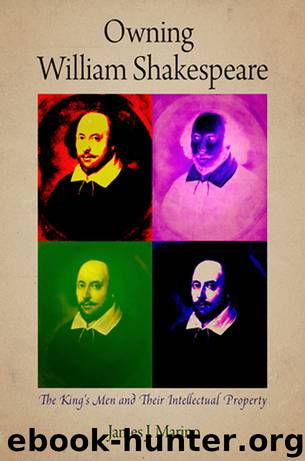Owning William Shakespeare by Marino James J.;

Author:Marino, James J.;
Language: eng
Format: epub
Publisher: University of Pennsylvania Press, Inc.
Published: 2011-04-05T04:00:00+00:00
Hamlet Delayed
Part of the reluctance to accept the references to the Admiral’s Men involves dating. Allusions to Henslowe’s Jephthah and Osric plays, written in 1602, would give all of the Hamlet texts a very late date indeed, close to the publication of the First Quarto and after James Roberts’s registration of the play on July 26, 1602. Jephthah seems to have been first staged sometime that June, and Marshal Osric was not commissioned until that September, after Hamlet’s entrance in the Stationers’ Register. Unless the references to Jephthah and Osric can be dismissed as coincidence, with Henslowe happening to commission entire plays about characters of those names shortly after Shakespeare’s play was performed, then the Hamlet texts (particularly the “good” ones, which name Osric) must have been composed after Roberts’s entry. If the composition of a Shakespeare play is imagined as a discrete event, with the entire text created at a single historical moment, this seems to be an impossibility. But if the Jephthah and Osric references were added through small acts of revision at different moments, those additions could have been made at any time before the plays went to press. Osric’s name could have been added as late as 1604. James Roberts, whose monopoly on printing playbills led him to do frequent business with all of the acting companies, may have acquired the text from which he set the Second Quarto after he entered his claim with his guild. Even in the narrative of publishing piracy founded by A. W. Pollard, Roberts has long been cast as the proverbial “good” stationer, cooperating with the actors and solicitous of their rights. It seems Hamlet continued to be revised between registration and printing, and there is no reason to believe the revisions stopped after publication.
A Hamlet open to revision as late as 1602 or 1604 (or 1623) leaves Shakespeare himself open to charges of imitation and influence. Rather than creating a singular masterpiece on a singular occasion, and thereby influencing his lesser competitors, William Shakespeare occupies one station in an intricate network of literary exchange, responding to other writers as they respond to him. Rather than being purely his own, Hamlet is contaminated with all manner of verbal traces from the works of other people, both predecessors and peers. For example, a Hamlet as late as 1602 would be subject to the influence of the revised Spanish Tragedy, with its mad scenes, or of John Marston’s Antonio’s Revenge, a Paul’s Boys play entered in the Stationers’ Register in 1601. Antonio’s Revenge has only a few ghostly verbal resemblances to Hamlet but both plays share a great many plot elements and basic motifs. In each play, the son of a murdered ruler is goaded to revenge by his father’s ghost and feigns mental incompetence to throw the murderous usurper off the scent. If Antonio’s Revenge is allowed chronological priority, the usual conclusion is that Shakespeare owes a “debt” either to Marston, whose plot he has imitated, or to the author of
Download
This site does not store any files on its server. We only index and link to content provided by other sites. Please contact the content providers to delete copyright contents if any and email us, we'll remove relevant links or contents immediately.
Aircraft Design of WWII: A Sketchbook by Lockheed Aircraft Corporation(31787)
The Great Music City by Andrea Baker(21929)
Call Me by Your Name by André Aciman(19011)
The Art of Boudoir Photography: How to Create Stunning Photographs of Women by Christa Meola(17870)
Shoot Sexy by Ryan Armbrust(17160)
The Secret History by Donna Tartt(16695)
Plagued by Fire by Paul Hendrickson(16647)
Portrait Mastery in Black & White: Learn the Signature Style of a Legendary Photographer by Tim Kelly(16498)
Adobe Camera Raw For Digital Photographers Only by Rob Sheppard(16407)
Photographically Speaking: A Deeper Look at Creating Stronger Images (Eva Spring's Library) by David duChemin(16173)
Bombshells: Glamour Girls of a Lifetime by Sullivan Steve(13129)
Pimp by Iceberg Slim(12961)
Ready Player One by Cline Ernest(12885)
The Goal (Off-Campus #4) by Elle Kennedy(12468)
Art Nude Photography Explained: How to Photograph and Understand Great Art Nude Images by Simon Walden(12372)
Kathy Andrews Collection by Kathy Andrews(10573)
Thirteen Reasons Why by Jay Asher(7816)
Wonder by R.J. Palacio(7757)
Goodbye, Things by Fumio Sasaki(7753)
